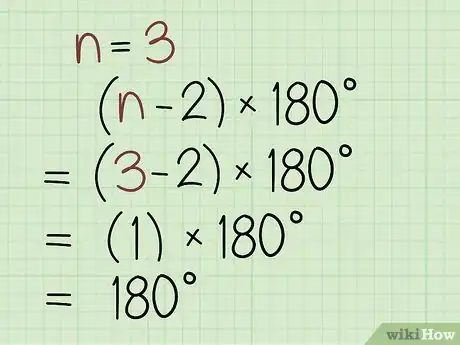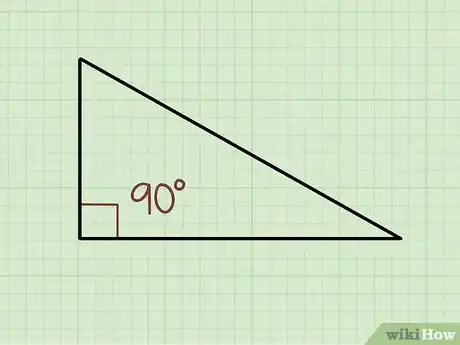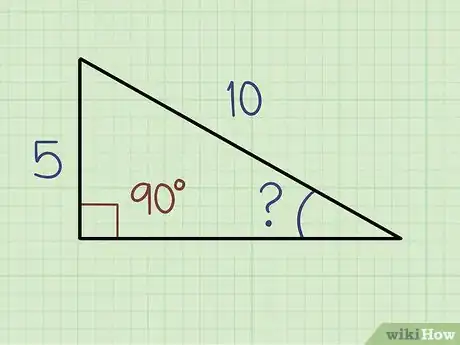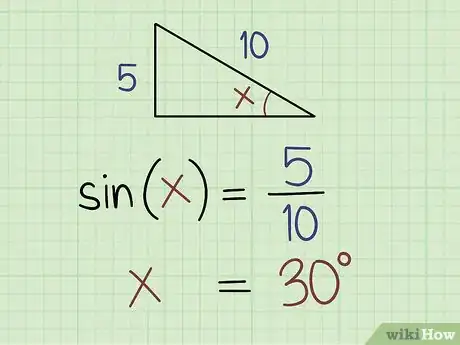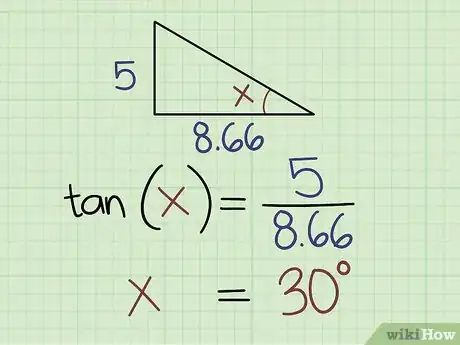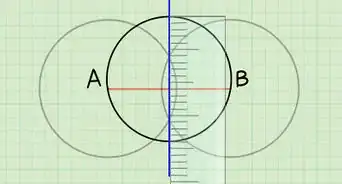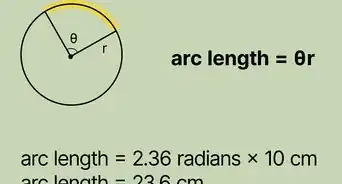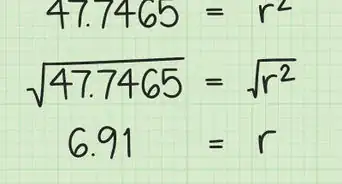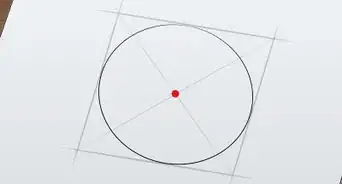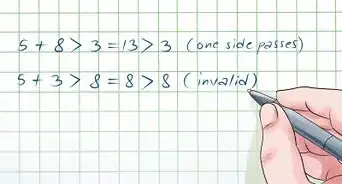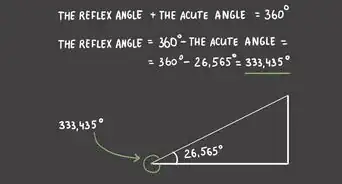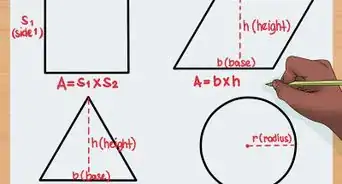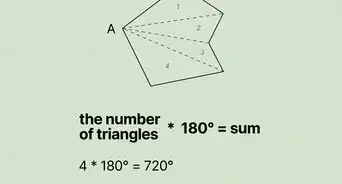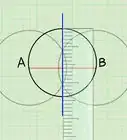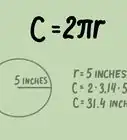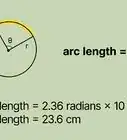This article was co-authored by Mario Banuelos, PhD and by wikiHow staff writer, Sophia Latorre. Mario Banuelos is an Assistant Professor of Mathematics at California State University, Fresno. With over eight years of teaching experience, Mario specializes in mathematical biology, optimization, statistical models for genome evolution, and data science. Mario holds a BA in Mathematics from California State University, Fresno, and a Ph.D. in Applied Mathematics from the University of California, Merced. Mario has taught at both the high school and collegiate levels.
This article has been viewed 666,025 times.
In geometry, an angle is the space between 2 rays (or line segments) with the same endpoint (or vertex). The most common way to measure angles is in degrees, with a full circle measuring 360 degrees. You can calculate the measure of an angle in a polygon if you know the shape of the polygon and the measure of its other angles or, in the case of a right triangle, if you know the measures of two of its sides. Additionally, you can measure angles using a protractor or calculate an angle without a protractor using a graphing calculator. This is to allow you to calculate angles
Steps
Calculating Interior Angles in a Polygon
-
1Count the number of sides in the polygon. In order to calculate the interior angles of a polygon, you need to first determine how many sides the polygon has. Note that a polygon has the same number of sides as it has angles.[1]
- For instance, a triangle has 3 sides and 3 interior angles while a square has 4 sides and 4 interior angles.
-
2Find the total measure of all of the interior angles in the polygon. The formula for finding the total measure of all interior angles in a polygon is: (n – 2) x 180. In this case, n is the number of sides the polygon has. Some common polygon total angle measures are as follows:[2]
- The angles in a triangle (a 3-sided polygon) total 180 degrees.
- The angles in a quadrilateral (a 4-sided polygon) total 360 degrees.
- The angles in a pentagon (a 5-sided polygon) total 540 degrees.
- The angles in a hexagon (a 6-sided polygon) total 720 degrees.
- The angles in an octagon (an 8-sided polygon) total 1080 degrees.
Advertisement -
3Divide the total measure of all of a regular polygon's angles by the number of its angles. A regular polygon is a polygon whose sides are all the same length and whose angles all have the same measure. For instance, the measure of each angle in an equilateral triangle is 180 ÷ 3, or 60 degrees, and the measure of each angle in a square is 360 ÷ 4, or 90 degrees.[3]
- Equilateral triangles and squares are examples of regular polygons, while the Pentagon in Washington, D.C. is an example of a regular pentagon and a stop sign is an example of a regular octagon.
-
4Subtract the sum of the known angles from the total measure of the angles for an irregular polygon. If your polygon doesn't have sides of the same length and angles of the same measure, all you need to do is add up all of the known angles in the polygon. Then, subtract that number from the total measure of all of the angles to find the missing angle.[4]
- For example, if you know that 4 of the angles in a pentagon measure 80, 100, 120, and 140 degrees, add the numbers together to get a sum of 440. Then, subtract this sum from the total angle measure for a pentagon, which is 540 degrees: 540 – 440 = 100 degrees. So, the missing angle is 100 degrees.
Tip: Some polygons offer “cheats” to help you figure out the measure of the unknown angle. An isosceles triangle is a triangle with 2 sides of equal length and 2 angles of equal measure. A parallelogram is a quadrilateral with opposite sides of equal lengths and angles diagonally opposite each other of equal measure.
Finding Angles in a Right Triangle
-
1Remember that every right triangle has one angle equal to 90 degrees. By definition, a right triangle will always have one angle that's 90 degrees, even if it's not labeled as such. So, you will always know at least one angle and can use trigonometry to find out the other 2 angles.[5]
-
2Measure the length of 2 of the triangle's sides. The longest side of a triangle is called the “hypotenuse.” The “adjacent” side is adjacent (or next to) to the angle you're trying to determine.[6] The “opposite” side is opposite to the angle you're trying to determine. Measure 2 of the sides so you can determine the measure of the remaining angles in the triangle.[7]
Tip: You can use a graphing calculator to solve your equations or find a table online that lists the values for various sine, cosine, and tangent functions.
-
3Use the sine function if you know the length of the opposite side and the hypotenuse. Plug your values into the equation: sine (x) = opposite ÷ hypotenuse. Say that the length of the opposite side is 5 and the length of the hypotenuse is 10. Divide 5 by 10, which is equal to 0.5. Now you know that sine (x) = 0.5 which is the same as x = sine-1 (0.5).[8]
- If you have a graphing calculator, simply type 0.5 and press sine-1. If you don't have a graphing calculator, use an online chart to find the value. Both will show that x = 30 degrees.
-
4Use the cosine function if you know the length of the adjacent side and the hypotenuse. For this type of problem, use the equation: cosine (x) = adjacent ÷ hypotenuse. If the length of the adjacent side is 1.666 and the length of the hypotenuse is 2.0, divide 1.666 by 2, which is equal to 0.833. So, cosine (x) = 0.833 or x = cosine-1 (0.833).[9]
- Plug 0.833 into your graphing calculator and press cosine-1. Alternatively, look up the value in a cosine chart. The answer is 33.6 degrees.
-
5Use the tangent function if you know the length of the opposite side and the adjacent side. The equation for tangent functions is tangent (x) = opposite ÷ adjacent. Say you know the length of the opposite side is 75 and the length of the adjacent side is 100. Divide 75 by 100, which is 0.75. This means that tangent (x) = 0.75, which is the same as x = tangent-1 (0.75).[10]
- Find the value in a tangent chart or press 0.75 on your graphing calculator, then tangent-1. This is equal to 36.9 degrees.
Expert Q&A
Did you know you can get expert answers for this article?
Unlock expert answers by supporting wikiHow
-
QuestionHow do you find an angle?
 Mario Banuelos, PhDMario Banuelos is an Assistant Professor of Mathematics at California State University, Fresno. With over eight years of teaching experience, Mario specializes in mathematical biology, optimization, statistical models for genome evolution, and data science. Mario holds a BA in Mathematics from California State University, Fresno, and a Ph.D. in Applied Mathematics from the University of California, Merced. Mario has taught at both the high school and collegiate levels.
Mario Banuelos, PhDMario Banuelos is an Assistant Professor of Mathematics at California State University, Fresno. With over eight years of teaching experience, Mario specializes in mathematical biology, optimization, statistical models for genome evolution, and data science. Mario holds a BA in Mathematics from California State University, Fresno, and a Ph.D. in Applied Mathematics from the University of California, Merced. Mario has taught at both the high school and collegiate levels.
Assistant Professor of Mathematics
-
QuestionHow do I create a 90 degree corner by swinging an arch?
 DonaganTop AnswererPick a convenient point on a line to be the vertex of your 90° angle. Choose two points on the line, one on each side of the vertex and equidistant from the vertex. Use a compass to draw two arcs of the same diameter, each centered on one of those latter points. Draw a line connecting the vertex point with the intersecting point(s) of the arcs. That line describes a 90° angle with the first line.
DonaganTop AnswererPick a convenient point on a line to be the vertex of your 90° angle. Choose two points on the line, one on each side of the vertex and equidistant from the vertex. Use a compass to draw two arcs of the same diameter, each centered on one of those latter points. Draw a line connecting the vertex point with the intersecting point(s) of the arcs. That line describes a 90° angle with the first line. -
QuestionHow do I find the interior angles of a hexagon without base or height or anything?
 DonaganTop AnswererThe sum of the six interior angles of a regular polygon is (n-2)(180°), where n is the number of sides. Therefore, in a hexagon the sum of the angles is (4)(180°) = 720°. All the angles are equal, so divide 720° by 6 to get 120°, the size of each interior angle.
DonaganTop AnswererThe sum of the six interior angles of a regular polygon is (n-2)(180°), where n is the number of sides. Therefore, in a hexagon the sum of the angles is (4)(180°) = 720°. All the angles are equal, so divide 720° by 6 to get 120°, the size of each interior angle.
References
- ↑ https://www.mathsisfun.com/geometry/interior-angles-polygons.html
- ↑ https://www.mathsisfun.com/geometry/interior-angles-polygons.html
- ↑ https://www.bbc.co.uk/bitesize/guides/zshb97h/revision/6
- ↑ https://www.mathopenref.com/polygoninteriorangles.html
- ↑ https://www.mathsisfun.com/algebra/trig-finding-angle-right-triangle.html
- ↑ https://www.mathsisfun.com/algebra/trig-finding-angle-right-triangle.html
- ↑ Mario Banuelos, PhD. Assistant Professor of Mathematics. Expert Interview. 19 January 2021.
- ↑ https://sciencing.com/angle-right-triangle-8159743.html
- ↑ https://sciencing.com/angle-right-triangle-8159743.html
About This Article
To calculate the angles inside a polygon, first count the number of interior angles. A polygon has the same number of interior angles as sides. For example, a triangle always has 3 angles, while a square or rectangle always has 4, and so on. Next, use the formula (n – 2) x 180 to find the total number of degrees of all the interior angles combined. In this formula, n is equal to the number of interior angles. So, a triangle would have (3 – 2) x 180 degrees, or 180 degrees total. On the other hand, a quadrilateral, such as a square or a rectangle, would have (4 – 2) x 180 degrees, or a total of 360 degrees. If the polygon is regular—that is, if all the sides are the same length—then all you have to do is divide the total number of degrees of all the interior angles by the number of sides in the polygon. For instance, to calculate the angles in a regular pentagon, divide 540 degrees by 5 to get 108. Each angle in the pentagon is 108 degrees. If the polygon has irregular sides, your job is a little trickier. If you know all the angles in the polygon but one, you can add the known angles up and subtract the sum from the total number of degrees of all the interior angles. This will give you the number of degrees in the missing angle. In other cases, you may need to look up a formula or function that’s specific to the type of polygon you’re working with. For instance, you can use a sine, cosine, or tan function to find the angles in a right triangle depending on which angle you’re calculating and which side lengths you know. To find out how to calculate angle measure in a right triangle, read on!

